Treaties recognize Indian tribes as sovereign nations that exercise exclusive authority over all peoples and activities within their territories. They are as valid today as on the day they were signed and ratified. Treaties are living documents, the “supreme Law of the Land” that continues to bind us together in this place we call home.
Today, treaties continue to affirm the inherent sovereignty of American Indian nations, enabling tribal governments to maintain a nation-to-nation relationship with the United States government; manage their lands, resources, and economies; protect their people; and build a more secure future for generations to come.
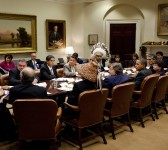
President Barack Obama meets with tribal leaders, including Fond du Lac tribal Chairwoman Karen Diver (seated to his left), in the Roosevelt Room of the White House, December 15, 2010. | Photo by Pete Souza, courtesy of the White House
Governing Modern Tribes
Most contemporary tribal governments are modeled on the American governance system. They have an executive branch, usually headed by a tribal chairperson; a legislative branch, or tribal council, that makes laws; and some have a judicial branch, or tribal court, that interprets laws passed by the tribal council.
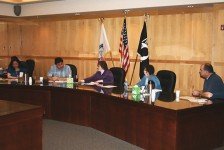
Fond du Lac tribal council meeting in session, about 2010. Council members include (from left) District III Representative Mary Northrup, Secretary-Treasurer Ferdinand Martineau Jr., Chairwoman Karen Diver, District II Representative Sandra Shabiash, and District I Representative Wally Dupuis. | Photo by Daniel Huculak, courtesy of the Fond du Lac Band of Lake Superior Chippewa
Lawmaking and Law Enforcement
Tribal governments make their own laws through their legislative councils and enforce them through their own agencies. Some tribal governments also protect their people through tribal courts and law enforcement.

The Mille Lacs Band of Ojibwe Police Department has 20 full-time officers who help ensure the safety and security of band members. | Courtesy of the Mille Lacs Band of Ojibwe
Continuing Nation-to-Nation Relationships
Treaties recognized American Indian tribes as sovereign nations, and established a tradition of nation-to-nation diplomacy with the United States that continues today. Although states have attempted to exert power over relations with tribal governments, Congress has the ultimate authority.
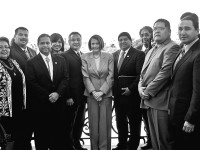
Throughout history, Native delegates have traveled to Washington, D.C., to meet with American leaders. In 2009, Red Lake and other tribal leaders came to meet with government representatives, including Speaker of the House of Representatives Nancy Pelosi (center). | Courtesy of the Red Lake Nation
Contemporary tribal governments manage their own territories in keeping with their traditional responsibility of caring for the land for future generations. Tribes protect treaty-guaranteed hunting, fishing, and wild rice gathering rights, and use cutting-edge technologies to manage and protect natural resources, including constructing energy-efficient buildings and producing clean energy.
Protecting Fish Habitat
Today, many Ojibwe tribes exercise sovereignty through responsible management and conservation of lakes and waterways. Tribes enact conservation codes that govern fishing methods and seasons as well as catch and size limits. The laws are enforced by tribal conservation wardens, and violators face fines or dates in tribal courts.
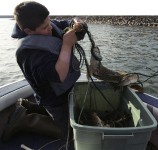
Nine-year-old Ben Sam (Mille Lacs) hauls in a 100-foot net filled with walleye, northern pike, and suckers on Mille Lacs Lake, 2004. | Photo by Sue Erickson, courtesy of the Great Lakes Indian Fish and Wildlife Commission
Intertribal Resource Management
The Grand Portage and Bois Forte bands of the Lake Superior Chippewa belong to the 1854 Treaty Authority, an intertribal organization that manages the off-reservation hunting, fishing, and gathering rights of members on lands ceded to the United States under the Treaty of 1854.
The Fond du Lac and Mille Lacs Ojibwe belong to the Great Lakes Indian Fish and Wildlife Commission, an organization of 11 Ojibwe nations in Minnesota, Wisconsin, and Michigan. These nations reserved hunting, fishing, and gathering rights in the treaties of 1837, 1842, and 1854.
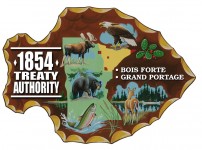
Insignia of the 1854 Treaty Authority and of the Great Lakes Indian Fish and Wildlife Commission

Insignia of the 1854 Treaty Authority and of the Great Lakes Indian Fish and Wildlife Commission
Reclaiming and Conserving
In 2006, the Shakopee Mdewakanton Sioux Community opened its own water reclamation facility, equipped with the advanced technology water quality testing lab, to treat wastewater formerly discharged into the Minnesota River through a local government-operated sewer system. Today, water treated at the tribal facility is used for irrigation, which has reduced pollution and cut water usage by 35 million gallons per year.

Shakopee Mdewakanton Sioux Community water reclamation facility | Courtesy Shakopee Mdewakanton Sioux Community
Innovative Insulation
The Shakopee Mdewakanton Sioux Community planted grasses and flowers on the 32,648-square-foot roof of the Dakotah! Sport and Fitness Ice Arena, which features the Midwest’s largest green roof. Vegetation insulates the building from exterior heat and cold, lowers tribal energy use, reduces storm water runoff, and provides a habitat for bees and insects.
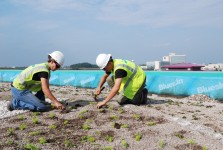
Workers plant grasses and flowers on the roof of the Dakotah! Sport and Fitness Ice Arena | Courtesy Shakopee Mdewakanton Sioux Community
American Indian nations manage the economic development of their communities by creating sustainable businesses that strengthen tribal independence. Tribal nations use revenues to provide jobs, support tribal services, and diversify reservation economies.

Where Minnesota Tribal Gaming Dollars Go
Data courtesy of the Minnesota Indian Gaming Association
Gaming
In the 1980s, American Indian tribes asserted their sovereign rights to economic self determination – free from state regulation – by created compacts to open gaming enterprises. The federal government passed the Indian Gaming Regulatory Act (1988), which reaffirmed tribal rights to conduct gaming on Indian lands as a means of developing reservation economies and promoting the welfare of the tribe.
Today, the 11 tribal governments in Minnesota operate 18 casinos, which have reduced tribal unemployment and generated revenues that support reservation business development, education, and social services.

Guests playing slot machines at the Grand Portage Lodge and Casino, the largest employer in Cook County. | Courtesy of the Grand Portage Band of Lake Superior Chippewa
Pop up photo: Guests playing slot machines at the Grand Portage Lodge and Casino, the largest employer in Cook County. | Courtesy of the Grand Portage Band of Lake Superior Chippewa
Self-Reliance Through Clean Energy
Tribal nations in Minnesota are investing in businesses that produce energy in more cost-effective and environmentally friendly ways. Their goal: to promote sustainable enterprises that support tribal self-reliance.

The product of a joint partnership between the Shakopee Mdewakanton Sioux Community and Rahr Malting, the six silos at the Koda Energy facility hold agricultural byproducts that are burned to generate power. Cleaner than a coal plant, Koda Energy is the only facility in the United States that uses natural materials exclusively to produce energy. | Courtesy of the Shakopee Mdewakanton Sioux Community
Pop up photo: The product of a joint partnership between the Shakopee Mdewakanton Sioux Community and Rahr Malting, the six silos at the Koda Energy facility hold agricultural byproducts that are burned to generate power. Cleaner than a coal plant, Koda Energy is the only facility in the United States that uses natural materials exclusively to produce energy. | Courtesy of the Shakopee Mdewakanton Sioux Community
The Business of Native Foods
Essential to survival, food has always been an expression of Native family, community, and cultural values. Today, some tribes in Minnesota operate businesses that sell traditional Ojibwe and Dakota foods, including wild rice, fish, wild berry jams, and a cornucopia of other products that reflect time-honored hunting, gathering, growing, harvesting, and cooking traditions.
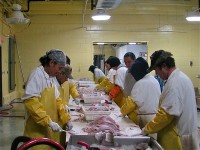
Workers clean and filet fresh walleye at a commercial processing plant at the Red Lake Nation, near Redby. Closed for nearly a decade due to overfishing on Red Lake, the plant reopened in 2008 after a joint tribal, state, and federal program restored the walleye population. | Courtesy of the Red Lake Nation Fisheries
Pop up photo: Workers clean and filet fresh walleye at a commercial processing plant at the Red Lake Nation, near Redby. Closed for nearly a decade due to overfishing on Red Lake, the plant reopened in 2008 after a joint tribal, state, and federal program restored the walleye population. | Courtesy of the Red Lake Nation Fisheries

At White Earth, a Native-operated not-for-profit organization has constructed a wind turbine to generate low-cost electricity and reduce consumption of fossil fuels. | Courtesy of the White Earth Land Recovery Project

Red Lake Nation Foods produces Native foods such as wild rice, preserves, and fish batter mix, for sale online. | Photo by Joel Rohde, courtesy of the Red Lake Nation Foods, Inc.

Bountiful harvests from Mdewakanton Wozupi, Shakopee’s organic garden, are sold at farmer’s markets and the tribe’s natural food market, Mazopiya, both of which became operational in 2010. | Courtesy of the Shakopee Mdewakanton Sioux Community
Just as their ancestors made decisions about the well-being of their people, modern Dakota and Ojibwe tribal leaders serve as caretakers of their people in the 21st century. That responsibility requires compassion, commitment, hard work, and vision—qualities that have enabled tribal governments to provide better housing, affordable health care, and other programs and services to tribal members.
Housing for All
Providing comfortable housing for all tribal members is a key objective of modern tribal governments. In 2010, the Fond du Lac Band of Lake Superior Chippewa completed construction of permanent housing for homeless families and individuals. Fond du Lac Supportive Housing consists of 24 units on a seven-acre site near the band’s Min No Aya Win Human Services Center.

Fond du Lac Supportive Housing | Photo by Daniel Huculak, courtesy of the Fond du Lac Band of Lake Superior Chippewa
Connecting with the Community
Modern tribal leaders are tasked with running complex government operations. Yet at feasts, celebrations, and other public events, tribal leaders make time to take the community’s collective pulse by listening to their citizens’ needs, desires, and opinions.
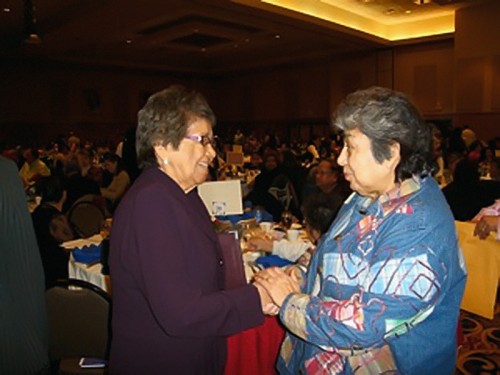
The late Mille Lacs Band of Ojibwe Chief Executive Marge Anderson (left) greets a band member at a tribal function. Under her leadership, the band built new schools, health clinics, community centers, housing, a water treatment plant, and other infrastructure. | Courtesy of the Mille Lacs Band of Ojibwe
Wellness
Tribal health clinics combine cutting-edge medical treatments with traditional remedies to address a range of health issues in reservation communities. The clinics provide immunizations, physicals, dental screenings, and other services for tribal members.

A young member of the Mille Lacs Band of Ojibwe smiles during a dental screening at one of the band’s three health clinics.| Courtesy of the Mille Lacs Band of Ojibwe
Treaties are living documents that recognize American Indian governments and guarantee the preservation of Native lands and lifeways for future generations. Today, more than 145 years after their treaties were signed, Indian tribes in Minnesota celebrate their treaties and their status as sovereign nations.
Like a muscle, sovereignty grows stronger the more we exercise it. Like a muscle, it takes on a more defined shape in the eyes of others, who recognize its power and potential. And like a muscle, it pumps the life blood that sustains a nation’s people.
— Kevin Leecy, Tribal Chairman, Bois Forte Band of Chippewa

Bois Forte Tribal Chair Kevin Leecy; District I Representative Cathy Chavers (partially hidden); Kristen Lilya, sixth-grader and student council president at the Nett Lake School; and tribal Secretary-Treasurer David Morrison at a ribbon-cutting ceremony for the new Bois Forte government and community services center in Nett Lake, 2010. | Photo by Jeff Henningsgaard, courtesy of the Bois Forte Band of Chippewa
Our ancestors’ lives were organized around their landscape. Their food, fiber, and spiritual life were based on the land on which they lived. Our culture and landscape is intimately intertwined. We have to have the landscape in order to preserve our culture.
— Stanley R. Crooks, Chairman, Shakopee Mdewakanton Sioux Community
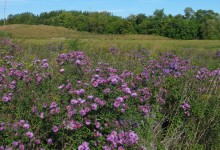
Grasses and wildflowers grow at the Shakopee Mdewakanton Sioux Community as they did centuries ago, thanks to the tribe’s prairie restoration program. | Courtesy of the Shakopee Mdewakanton Sioux Community
Bimaadiziwin: Preserving the “Good Life”
As they face the 21st century, Native people in Minnesota are drawing on treaty rights and tribal traditions to find balance in an ever-changing world. By restoring prairie habitat, revitalizing their languages, and celebrating their heritage, the tribes are exercising their rights as sovereign nations as well as embracing the Ojibwe concept of bimaadiziwin—the “good life.”

John Whiteman (left) and Parker Drift conduct research in their classroom at the Nett Lake School, Bois Forte Reservation, 2009. The computers were donated by the Fortune Bay Resort Casino, which is owned and operated by the Bois Forte Band. | Photo by Helen Wilkie, courtesy of the Bois Forte Band of Chippewa

An honor guard presents the flags of the United States and Indian nations at the annual Mille Lacs Traditional Powwow, 2010. | Courtesy of the Mille Lacs Band of Ojibwe
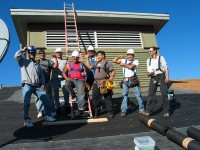
Construction workers from Bois Forte and the Keweenaw Bay Reservation in Michigan share a lighthearted moment while installing a roof on the hotel at the Fortune Bay Casino on the Bois Forte Reservation. | Photo by Helen Wilkie, courtesy of the Bois Forte Band of Chippewa































